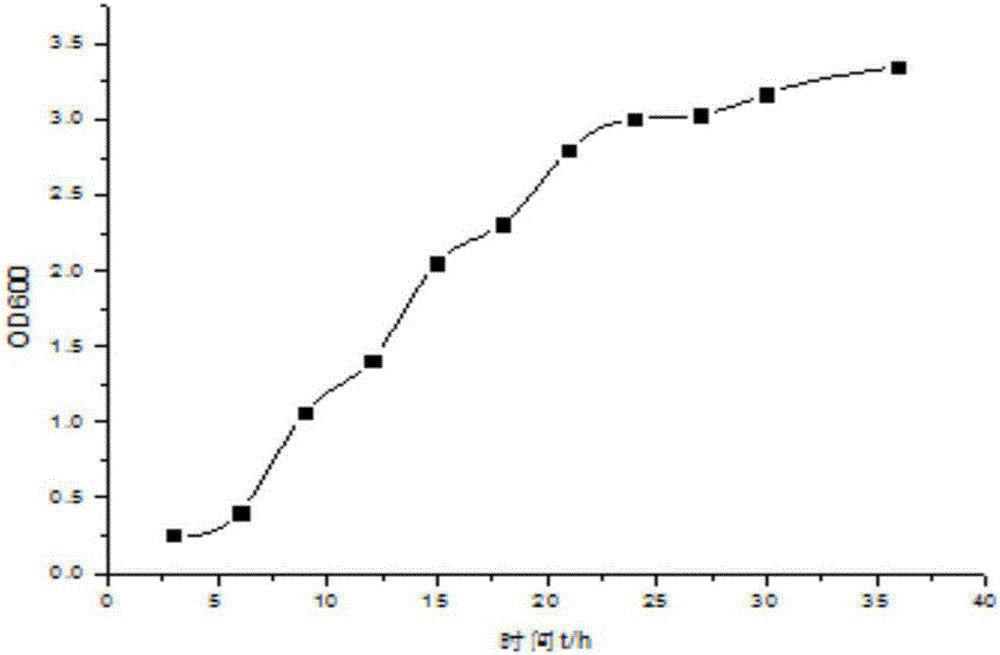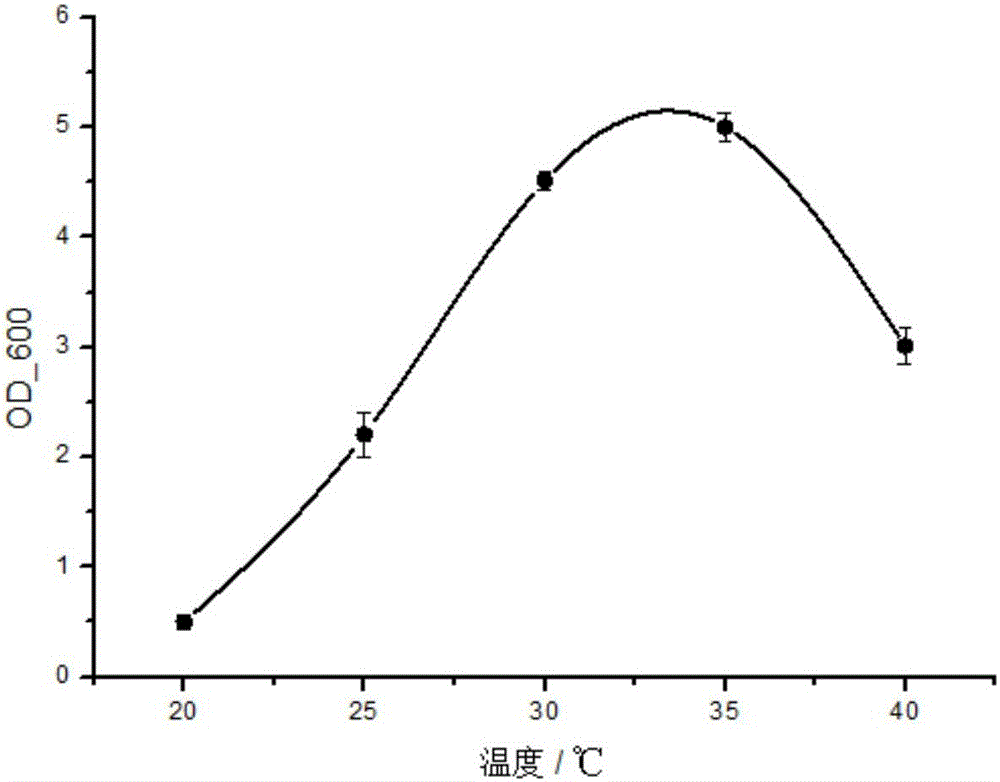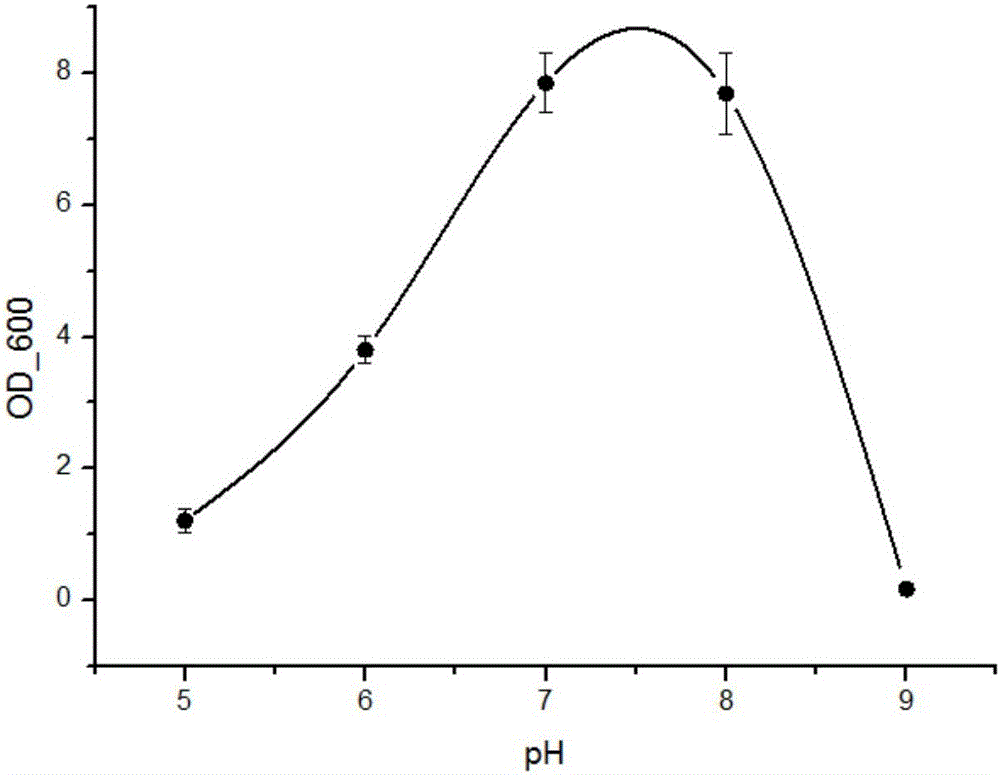Optimum growth condition of Klebsiella oxytoca strain for degrading petroleum pollutants and tolerance research method
A technology of Klebsiella and growth conditions, which is applied in the field of research on the optimal growth conditions and tolerance of Klebsiella degrading petroleum pollutants, and can solve the problems that microorganisms cannot grow and degrade petroleum, and the conditions are harsh
- Summary
- Abstract
- Description
- Claims
- Application Information
AI Technical Summary
Problems solved by technology
Method used
Image
Examples
Embodiment 1
[0024] Determination of Klebsiella growth
[0025] Configure basic tryptone soy broth medium, peptone 20g / L, glucose 2.5g / L, sodium chloride 5g / L, dipotassium phosphate 2.5g / L, using 2mol / L sodium hydroxide and 2mol / L Hydrochloric acid adjusts the pH of tryptone soy broth medium to 7. Dispense 100 mL of Tryptone Soy Broth Medium into 250 mL Erlenmeyer flasks, seal them with parafilm, and sterilize them at 121°C for 20 minutes under high temperature and high pressure. After cooling, add 1 mL of bacterial solution, incubate on a shaker at 30°C and 220 rpm, take samples every 3 hours and measure OD 600 value. Shake the Erlenmeyer flask well before each sampling, and sample 2mL. Make three parallels for each group. In order to ensure the accuracy of the instrument during the test, control the measured value within 0.2-0.8. If the measured value is too high, do the test after appropriate dilution. OD at 3h 600 The values are 0.267, 0.263, 0.234, 0.29, 0.32, 0.328 at 6h, 0.463, 0...
Embodiment 2
[0027] Determination of temperature tolerance of Klebsiella
[0028] Configure basic tryptone soy broth medium. Divide 100 mL of tryptone soy broth medium into 250 mL conical flasks, a total of 15 bottles, seal and sterilize and cool for use. Mix the Klebsiella bacteria liquid, add 1 mL of the bacteria liquid to each bottle of culture medium, and each 3 bottles form a group, respectively at 20 ℃, 25 ℃, 30 ℃, 35 ℃, 40 ℃, 220 rpm after shaking for 27 hours Sampling test. Mix and shake the flasks before sampling, and sample 2mL of each flask to test the OD of the bacterial solution 600 If the concentration is too high, the bacteria liquid should be diluted appropriately. After eliminating the measurement values with obvious errors in each group, take the average value and draw the temperature tolerance diagram of Klebsiella HA1 under the condition of 20-40℃, such as figure 2 Shown. The results show that Klebsiella LF1 has the best growth at 35°C, the optimum temperature is bet...
Embodiment 3
[0030] Determination of Klebsiella pH tolerance
[0031] It is equipped with special tryptone soy broth medium for pH tolerance determination, peptone 20g / L, glucose 2.5g / L, sodium chloride 5g / L, and dipotassium hydrogen phosphate 2.5g / L. Divide 100mL of Tryptone Soy Broth Medium into 250mL Erlenmeyer Flasks, a total of 15 bottles, 3 bottles each as a group, adjust the pH with 2mol / L sodium hydroxide and 2mol / L hydrochloric acid respectively For 5, 6, 7, 8, and 9, after sealing with parafilm, sterilize at 121°C for 20 minutes under high temperature and high pressure. Mix the Klebsiella bacteria solution, add 1 mL of the bacteria solution to each bottle of culture medium, incubate at 30° C., 220 rpm for 27 hours, and then sample for testing. Mix and shake the flasks before sampling, and sample 2mL of each flask to test the OD of the bacterial solution 600 If the concentration is too high, the bacteria liquid should be diluted appropriately. After eliminating the measurement valu...
PUM
 Login to view more
Login to view more Abstract
Description
Claims
Application Information
 Login to view more
Login to view more - R&D Engineer
- R&D Manager
- IP Professional
- Industry Leading Data Capabilities
- Powerful AI technology
- Patent DNA Extraction
Browse by: Latest US Patents, China's latest patents, Technical Efficacy Thesaurus, Application Domain, Technology Topic.
© 2024 PatSnap. All rights reserved.Legal|Privacy policy|Modern Slavery Act Transparency Statement|Sitemap



